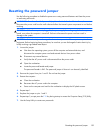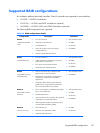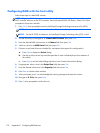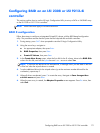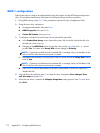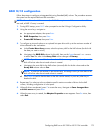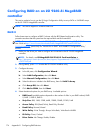
Supported RAID configurations
All workstation platforms have Intel controllers. Three LSI controllers are supported on some platforms:
●
LSI 2308 — HP Z820 Workstations
●
LSI 9212-4i — HP Z420 and Z620 Workstations (optional)
●
LSI 9260-8i — HP Z420, Z620, and Z820 Workstations (optional)
The following RAID configurations are supported.
Table B-2 RAID configuration details
Configuration Description Controllers
RAID 0
Integrated striped disk
array
●
Two drive minimum.
●
Improved I/O performance.
●
No fault tolerance.
●
Failure of any disk in the array results in
complete data loss.
●
Used to increase disk performance.
●
Intel with RSTe or RST
●
LSI 2308
●
LSI 9212-4i
●
LSI 9260-8i
RAID 1
Mirrored disk array
●
Two drive maximum.
●
100% redundancy: all data from one drive is
duplicated on a second drive.
●
Can recover from single drive failure.
●
Good entry-level redundant system.
●
Intel with RSTe or RST
●
LSI 2308
●
LSI 9212-4i
●
LSI 9260-8i
RAID 5
Striped disk array with
distributed parity
●
Three or more drives (for workstations that
support three or more hard drives).
●
Fault tolerant and provides I/O performance
improvement, especially for write-biased
applications.
●
Single drive failure does not cause data loss
(performance is compromised until the failed
drive is replaced and the array rebuilt).
●
Intel with RSTe or RST
●
LSI 9260-8i
RAID 10
Striped and mirrored
disk array
●
Four or more disks (for workstations that support
four or more hard drives).
●
Excellent performance.
●
Uses several drives to stripe data, then copies the
striped drives to provide redundancy.
●
Offers high data transfer of striped arrays and
increased data accessibility (reads).
●
Intel with RSTe or RST
●
LSI 2308
●
LSI 9212-4i
●
LSI 9260-8i
RAID 1E
Two-way mirroring
●
Similar to RAID 10.
●
Must have an odd number of disks.
●
Improved read performance.
●
LSI 2308
●
LSI 9212-4i
Supported RAID configurations
167



